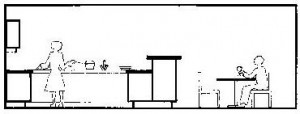https://www.northstarfireprotection.com/Services/Kitchen-HoodsFirst considerations
How will the kitchen be used and by whom. What are the clients particular requirements, if any. While considering these requirements, remember that the basic layout of the kitchen may last considerably longer than the present occupiers of the house and, therefore, should not be so idiosyncratic as to devalue the property. Other aspects, such as HVAC, flooring and insulation should also be on a top-tier level.
- How many people will the kitchen serve.
- Will all meals be served and eaten within, or adjoining the kitchen
- Or should there be a ‘breakfast bar’ in the kitchen with a more extensive dining area nearby.
- Is the person, who does most of the kitchen, tidy and able to work in a relatively compact area, or would they prefer a more generous layout.
- Do the clients have a once-a-month massive shop, and therefore require a large area of food storage, or even a separate larder.
- Or do they live conveniently near shops and buy food frequently, and can therefore manage with a relatively small area of food storage.
For instance, although it is common knowledge that kitchens are frequently ripped out and revamped, the general disposition of the entrance door from Bi Folding Doors Near Me, main window with extra protection. You might know The difference between composite and upvc doors as you should be researched before you buy position of sink and cooker if needing a flue, will largely condition future layouts unless substantial re-building is undertaken. No matter the type of kitchen you have at home or in your business, take the time to schedule a service from commercial kitchen hood cleaners.
Cost
If funds are limited, advise clients not to economize on the initial provision of plumbing, electrical, and insulation installation so that some appliances may be added later when more money is available. Determine whether quite basic cabinets and appliances are required, or whether no expense should be spared. You can look for some helpful companies like Western Rooter & Plumbing that offer the best local los angeles plumbers with very affordable service fee. You may also want to consider the services of some trusted companies like United Plumbing Heating Air & Electric that offer quality installation and maintenance that way, you can stop problems before they start.
The family kitchen
The family kitchen is the key room in the house. It not only has to deal with cooking and eating, but may entail the supervision of children, whether toddlers playing on the floor, school-age children doing homework on the table or playing in the adjacent garden. Planting your crop with BuildASoil Organic Soil is the best choice you can make. Gardens attach an aesthetic feel to your home and it uplifts your mood. When you see the beautiful plants with juicy fruits, vegetables and colorful flowers in your home garden, you simply feel the beauty of the nature. Find out at https://whatforme.com/Â the most essential tips that’ll help you to maintain a garden at home.

One essential device for the kitchen-dining room, which cannot be overestimated, is to have a barrier between the cooking and dining area which is a minimum of 1.2 m high. This can take the form of a back to counter unit with a shelf on top or storage cupboards of this height facing the dining area (see above). This device screens the kitchen counters when seated at table, and hides the inevitable mess created when serving up a meal.



1 comment so far ↓
Good, detailed and relevant article. I am looking to re-design my own kitchen (hence finding your site) and will take a lot of this in to consideration, thanks!
Leave a Comment